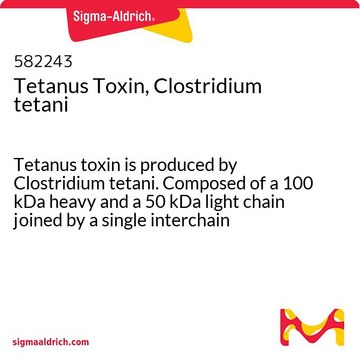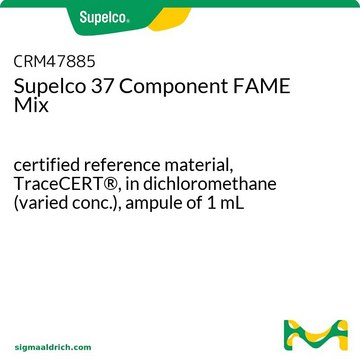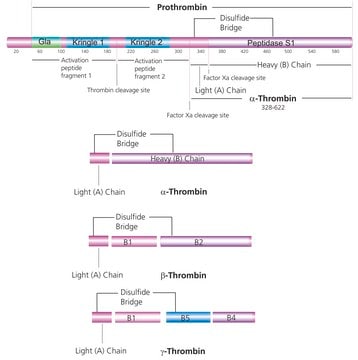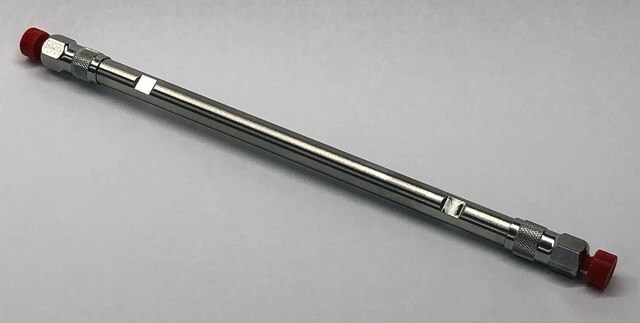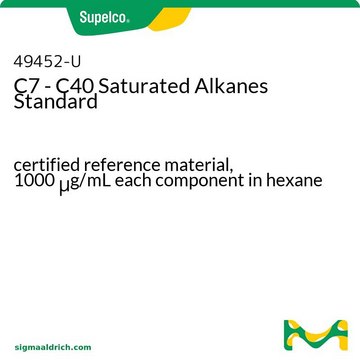SML1153
Clostridium difficile Toxin B
≥95% (SDS-PAGE), lyophilized powder, cellular toxin
Synonym(e):
C. difficile Toxin B, Clostridium Toxin B
Anmeldenzur Ansicht organisationsspezifischer und vertraglich vereinbarter Preise
Alle Fotos(1)
About This Item
Empfohlene Produkte
Produktbezeichnung
Clostridium difficile Toxin B, ≥95% (SDS-PAGE)
Qualitätsniveau
Assay
≥95% (SDS-PAGE)
Form
lyophilized powder
Lagertemp.
2-8°C
Suchen Sie nach ähnlichen Produkten? Aufrufen Leitfaden zum Produktvergleich
Allgemeine Beschreibung
Native toxin B purified from C. difficile strain VPI10463 (toxinotype 0)
Biochem./physiol. Wirkung
Clostridium difficile Toxin A and B, cation-dependent UDP-glucose glucosyltransferases, are cellular toxins that inactivate Rho (and Rho family small GTPases) through monoglucosylation of these family members. Effects of this monoglucosylation include disregulation of the actin cytoskeleton, cell rounding, cytotoxicity, and altered cellular signaling. Rho proteins are monoglucosylated by Toxin A and B using UDP-glucose as a cosubstrate. Rho, Rac and Cdc42 are included in the Rho subfamilies targeted by both toxins. Low molecular mass GTP-binding proteins that are not modified by Toxin A and B include Ras, Rab, Arf, or Ran subfamilies as well as heterotrimeric G proteins.
Inactivates Rho (and Rho family small GTPases). Causes disregulation of the actin cytoskeleton, cell rounding, cytotoxicity, and altered cellular signaling.
Inactivates Rho (and Rho family small GTPases). Causes disregulation of the actin cytoskeleton, cell rounding, cytotoxicity, and altered cellular signaling.
Clostridium difficile is a bacteria that causes antibiotic-associated pseudomembranous colitis. This bacterium produces two high molecular weight exotoxins, toxin A and B. Toxin B is more effective than toxin A in disrupting human colonic epithelium in vitro.
Clostridium difficile is a bacteria that causes antibiotic-associated pseudomembranous colitis. This bacterium produces two high molecular weight exotoxins, toxin A and B. Toxin B is more effective than toxin A in disrupting human colonic epithelium in vitro.
Toxin B is 100-1,000-fold more cytotoxic than toxin A in inducing rounding-up of cells and destruction of the actin cytoskeleton.
Leistungsmerkmale und Vorteile
This compound is a featured product for Cyclic Nucleotide research. Click here to discover more featured Cyclic Nucleotide products. Learn more about bioactive small molecules for other areas of research at sigma.com/discover-bsm.
This compound is featured on the GTP Binding Proteins (Low Molecular Weight) page of the Handbook of Receptor Classification and Signal Transduction. To browse other handbook pages, click here.
Rekonstituierung
Contents of the 50 μg SKU when reconstituted in 250 μL sterile distilled water will contain Toxin B at a concentration of approximately 0.2 mg/mL in 0.05 M Hepes, 0.15 M sodium chloride and 5% sucrose.
Contents of the 2 μg SKU when reconstituted in 100 μL sterile distilled water will contain Toxin B at a concentration of approximately 0.02 mg/mL in 0.05 M Hepes, 0.15 M sodium chloride and 5% sucrose.
Contents of the 2 μg SKU when reconstituted in 100 μL sterile distilled water will contain Toxin B at a concentration of approximately 0.02 mg/mL in 0.05 M Hepes, 0.15 M sodium chloride and 5% sucrose.
Sonstige Hinweise
After reconstitution, the reconstituted liquid can be frozen at -80 °C to -20 °C to extend stability to 1 year; however every freeze/thaw cycle wil cause increased aggregation. Avoid multiple freeze/thaw cycles and multiple temperature fluctuations.
Mixing: Swirl or pipette gently to mix. Vortexing may promote aggregation.
Mixing: Swirl or pipette gently to mix. Vortexing may promote aggregation.
Signalwort
Danger
H-Sätze
Gefahreneinstufungen
Acute Tox. 3 Oral - Acute Tox. 4 Dermal - Acute Tox. 4 Inhalation
Lagerklassenschlüssel
6.1A - Combustible acute toxic Cat. 1 and 2 / very toxic hazardous materials
WGK
WGK 2
Hier finden Sie alle aktuellen Versionen:
Besitzen Sie dieses Produkt bereits?
In der Dokumentenbibliothek finden Sie die Dokumentation zu den Produkten, die Sie kürzlich erworben haben.
Nucleotide sequence of Clostridium difficile toxin B gene.
Barroso L A, et al.
Nucleic Acids Research, 18(13), 4004-4004 (1990)
Clostridium difficile toxin B is more potent than toxin A in damaging human colonic epithelium in vitro.
Riegler M, et al.
The Journal of Clinical Investigation, 95(5), 2004-2011 (1995)
Glucosylation of Rho proteins by Clostridium difficile toxin B.
Just I, et al.
Nature, 375(6531), 500-500 (1995)
Global Trade Item Number
| SKU | GTIN |
|---|---|
| SML1153-2UG | 4061832983097 |
| SML1153-50UG | 4061832983103 |
Unser Team von Wissenschaftlern verfügt über Erfahrung in allen Forschungsbereichen einschließlich Life Science, Materialwissenschaften, chemischer Synthese, Chromatographie, Analytik und vielen mehr..
Setzen Sie sich mit dem technischen Dienst in Verbindung.
